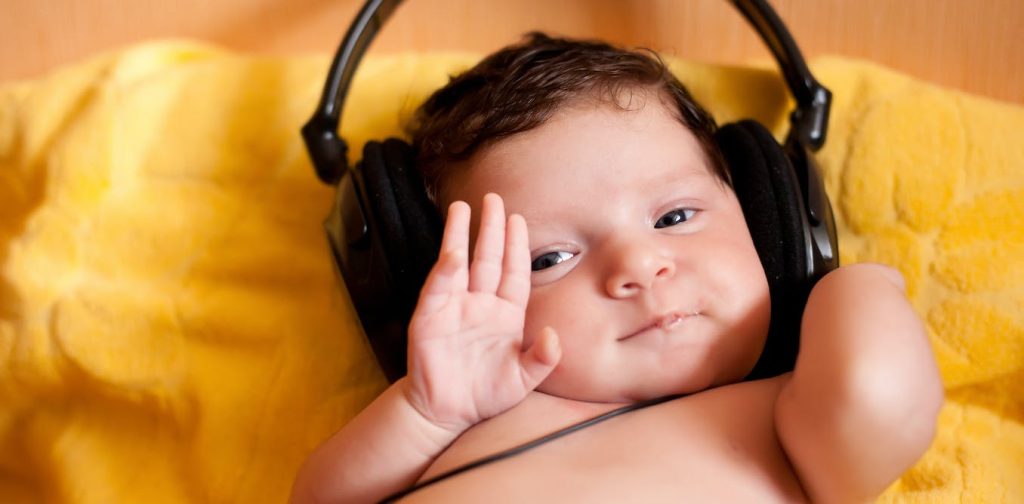Music is the language of emotions, arousing and regulating our feelings. For example, research has shown that college students listen to music 37% of the time, and it fills them with happiness, elation or nostalgia during 64% of these sessions.
Children might have even greater exposure to music than adults do. Survey data shows that 54% of teachers in South Korea use background music in schools. We also know music is played as often as 6.5 times per hour to help children’s learning in US classrooms.
But how early do children develop a real appreciation for and understanding of music? Our recent study, published in Psychological Studies, suggests newborns may be rather musical, finding happy music soothing in particular.
This could be seen as surprising because, ultimately, culture plays a major role in when and how we understand music – it’s something we learn. Preschoolers, for example, are often unable to pair pictures of happy or sad faces with happy or sad music. Such ability usually develops later in childhood.
It has long been unclear whether newborns and young children feel emotions in music. But we know that newborns respond to aspects of music, such as its beat, structure as well as consonance and dissonance.
Young infants also love “motherese”, a very musical, melodic and slow type of speech that adults often adopt when talking to babies. Even those babies who can hear but were born to deaf parents (who don’t speak to them in this way) pay attention to such speech or maternal-style singing.
Some research suggests even foetuses seem to respond to music. One study has shown that when pregnant women at the 28th week of gestation listen to their favourite songs, their foetuses‘ heartbeats increase, even though the mothers show no change in their heart rates.
Other studies, however, have failed to find any such reaction in foetuses. Music is often trialled to help prematurely born babies in neonatal intensive care units. But of the ten most rigorous studies with newborns in intensive care units, only half found any behavioural response to music, such as reduced crying, stress or pain. And only half of the studies found any effect on heart rates or blood pressure.
That said, very few studies have looked at how healthy, full-term newborns react to music. And no studies have examined how they respond to emotions in music.
Happy is calming
Our team looked at how music affected healthy newborns, who were carried to term. First, we wanted to select a music piece that was really happy, and another that was really sad.
Two experimenters collected and listened to hundreds of lullabies and children’s songs and selected 25 of these that sounded happy or sad. Only six of these were sung in English (Simple Simon, Humpty Dumpty, Hey Diddle Diddle, Little Miss Muffet, Ding Dong Bell, Little Bo Beep) while the others were in various other languages.
A total of 16 adult participants helped to rate the 25 songs for their emotional content. A French lullaby entitled Fais Dodo (by Alexandra Montano and Ruth Cunningham) was found to be the saddest, while a German song, Das singende Känguru (by Volker Rosin), was ranked the happiest.
We played these two songs in random order – along with a silent control period – to 32 babies in a first experiment. We also analysed how 20 behaviours, such as crying, yawning, sucking, sleeping and limb movements changed millisecond by millisecond during the music pieces and the silence, respectively.
In a second experiment, we recorded the heart rates of 66 newborn infants while they were listening to these two songs or silence.
Perhaps the most striking results was that babies started to downshift to sleep during happy music, but not to sad music or when there was no music. Also, they showed a decrease in their heart rates during happy music but not during sad music or silent periods, suggesting they were getting calmer.
In response to both happy and sad music, babies also moved their eyes less frequently and and there were longer pauses between their movements compared with the silence period. This might mean that both types of music had some calming effect on the babies compared with no music, but happy music was the best.
Our results suggests that newborns thus do react to emotions in music, and that responses to music are present at birth. Earlier, we worked with foetuses and found that second and third trimester foetuses respond when their mum is talking. So listening to talking, singing and music may pre-shape babies’ responses to music in the womb.
Traditionally, lullabies are sung by the caretakers, usually the mothers. Such singing is very personal and emotional. Mothers who come to our lab, often tell us that long forgotten lullabies they heard from their own mothers and grandmothers, suddenly come to their memory when singing to their own babies.
The mothers’ emotions when singing likely shapes their babies‘ responses to music.
Even with healthy babies, there is always a need for a soothing intervention as they cry on average for about two hours a day in the first weeks of life.
Soothing by music, played or sung, is widespread throughout the world and across times for a reason. Babies are born with an innate musicality and sensitively respond to music. And now we know that it is happy, animated and fast music that particularly resonates with their psychological and physical rhythms – enabling soothing, calming and sleeping.

